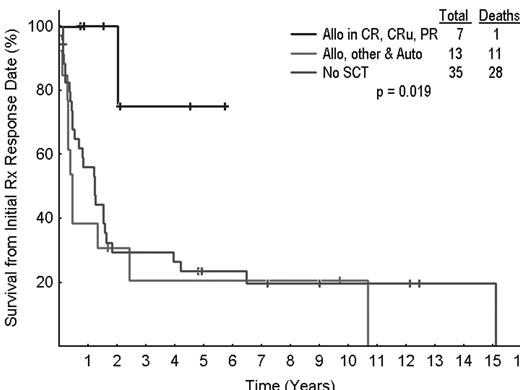Abstract
Introduction: Richter’s syndrome (RS) is a rare complication of chronic lymphocytic leukemia/small lymphocytic lymphoma (CLL/SLL). The clinical outcome is generally poor. The purpose of this study was to assess the presenting characteristics, treatment outcomes, and prognostic factors in patients with RS.
Methods: An electronic database search of patients with CLL/SLL or RS who presented at U. T. M. D. Anderson Cancer Center between 1/75 and 6/05 was performed.
Results: Among 3,986 patients with CLL/SLL, 204 patients (5.1%) had possible RS and 148 patients (3.7%) had biopsy- or fine-needle aspiration-proven RS. The median age was 61 years (range, 29–83 years); and 70% were men. Among 148 patients with RS, 53% were ≥ 60 years, 79% had Zubrod performance status 0–1, 47% had lactate dehydrogenase (LDH) levels ≥ 1.5 x the upper limit of normal, 57% had platelets ≥ 100 x 109/L, 57% had β 2-microglobulin ≥ 6 mg/dL (3 x the upper limit of normal), and 45% had tumor size >5 cm. Treatment included chemoimmunotherapy, such as rituximab with fractionated cyclophosphamide, vincristine, adriamycin, and dexamethasone (R-hyper-CVAD) or cyclophosphamide, doxorubicin, vincristine, and prednisone (R-CHOP), and chemotherapy. A total of 135 patients were treated and 130 patients were evaluable. The overall response rate was 39% (chemoimmunotherapy, 47%; chemotherapy, 34%, p=0.2). In multivariate analysis (MVA), factors predicting response were platelet counts ≥ 100,000 (p=0.02), hemoglobin levels ≥ 11g/dL (p=0.036), performance status (PS) 0 or 1 (p=0.037), and β 2-microglobulin <6 mg/dL (p=0.05). Factors predicting prolonged survival were PS 0–1 (p=0.006), LDH ≤ 1.5 x upper limit of normal (p=0.003), platelet counts ≥ 100,000 (p=0.01), tumor size ≤ 5 cm (p=0.02), and <2 prior therapies (p=0.02). Factors predicting prolonged FFS were PS 0–1 (p=0.006), LDH ≤ 1.5 x upper limit of normal (p=0.019), tumor size ≤ 5 cm (p=0.021), age <60 years (p=0.025), <2 prior therapies (p=0.041), and platelet counts ≥ 100,000 (p=0.045). A total of 20 patients underwent stem cell transplantation (SCT). Seven patients underwent allogeneic SCT as postremission therapy, and 13 patients underwent allogeneic SCT (n=10) or autologous SCT (n=3) as salvage therapy. Patients who underwent allogeneic SCT as postremission therapy appeared to have longer survival than patients who achieved remission and received no further therapy (n=35) or patients who underwent allogeneic or autologous SCT as salvage therapy (p=0.019).
Conclusions: Our results suggest that chemoimmunotherapy, such as R-Hyper-CVAD or R-CHOP, followed by allogeneic SCT results in longer survival compared to other therapies. Until curative therapies are developed, patients with available donors should be considered for allogeneic SCT as postremission therapy.
Author notes
Corresponding author


This feature is available to Subscribers Only
Sign In or Create an Account Close Modal